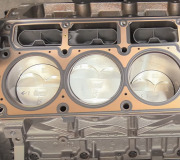Introduction
An automotive engine cylinder compression ratio is at the heart of all internal combustion engines and will help determine the amount of horsepower the engine will produce. In this guide, we’ll cover what cylinder compression is, how it affects an engine’s operation.
Engine Compression
Engine cylinder compression is the pressure generated within the engine's cylinders when the piston compresses the air-fuel mixture. This compressed mixture is then ignited, producing the power needed to drive the engine. In general the more compression an engine has, the more power it will produce, but there is catch, if compression is too high it will cause the engine to "ping" or "knock" as the control burn of the fuel becomes unstable.
The compression ratio of an engine is determined by the cylinder bore volume divided by the cylinder head combustion chamber volume which can be 8:1, (eight parts volume in the cylinder, to one part volume inside the combustion chamber). With direct fuel injection engines, for both gasoline and diesel fuels, the compression ratio can be 13:1 and up to 25:1.
Factors That Influence Cylinder Compression
Several factors contribute to engine cylinder compression, including:
- Piston Rings: These seal the piston to the cylinder wall. Worn or damaged piston rings can allow compression to escape.
- Valves and Valve Seals: Intake and exhaust valves need to close completely to maintain compression. Leaking valves or seals can reduce compression.
- Cylinder Head Gasket: A damaged head gasket can lead to compression loss between cylinders.
- Cylinder Wall Condition: Worn or scored cylinder walls prevent effective sealing, reducing compression.
- Combustion Chamber and Piston Dome Designs: These factors are directly related to the compression ratio.
Cylinder compression is measured in PSI (pounds per square inch) or BAR (atmospheric pressure units) and will typically be between 135 psi. and 150 psi. or 9.31 BAR and 10.34 BAR for gasoline engines, and as high as 400 PSI, (27.58 BAR) for diesel engines. To test compression a compression gauge is used to determine if the engine is worn out or if a particular cylinder has had a mechanical failure.
If an engine has a problem or is worn out, the compression will be lower than intended which will cause low power output, cylinder misfires and the engine not to start.
Watch the Video!
Here is a typical engine while running which displays the combustion process.
Credits
This guide knowledge base was created by the 2CarPros Team, and by Ken Lavacot: Automobile repair shop owner and certified master automobile technician of over 30 years. If you have question or need help please ask one of our experts we are happy to help. Please visit our 2CarPros YouTube Channel for additional car repairs.




